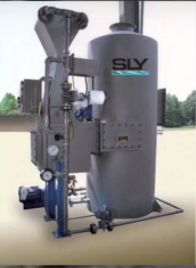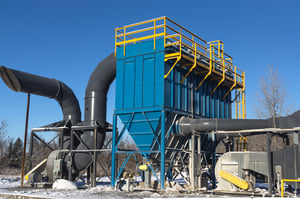Air pollution control systems fall into two main categories: wet scrubbers and dry dust collectors (including both baghouses and cartridge collectors). Each type has its place, but determining which is best for a particular application does require careful consideration.
Wet Scrubber Advantages and Disadvantages
 Nowhere are wet scrubbers more necessary than in environments with combustible dust. A combustible dust is a solid material composed of distinct particles or pieces less than 500 microns in size that presents a fire or deflagration hazard when suspended in air or some other oxidizing medium over a range of concentrations. Dust from foods, plant matter, metals, fuels, plastics, dyes and many other materials can be explosive when combined with other environmental conditions. For example, in food production, processes such as grinding, transferring or mixing ingredients can produce massive quantities of suspended particles. Electrical devices or processes that can produce sparks or heat can trigger an explosion, especially in areas where poor housekeeping practices have allowed dust to accumulate.
Nowhere are wet scrubbers more necessary than in environments with combustible dust. A combustible dust is a solid material composed of distinct particles or pieces less than 500 microns in size that presents a fire or deflagration hazard when suspended in air or some other oxidizing medium over a range of concentrations. Dust from foods, plant matter, metals, fuels, plastics, dyes and many other materials can be explosive when combined with other environmental conditions. For example, in food production, processes such as grinding, transferring or mixing ingredients can produce massive quantities of suspended particles. Electrical devices or processes that can produce sparks or heat can trigger an explosion, especially in areas where poor housekeeping practices have allowed dust to accumulate.
Wet scrubbers use water to remove dust from air, which reduces the heat source and dust cloud; they also eliminate the dust dispersion that is essential for combustion by aggregating dust particles within water droplets. Three different types of wet scrubbers are commonly used in industrial settings:
- Impinjet® wet scrubber. These collect particulates and clean, cool and absorb vapors and gases. They offer high collection efficiencies (99% for particles 5 microns or larger) with low water consumption and minimum pressure drop. Impinjet scrubbers are highly resistant to fouling and available with capacities as high as 200,000+ CFM.
- Venturi scrubbers. These collect fine particulates and mists. They use the differential between high velocity gases and free-flowing water to create fine droplets that can entrap contaminants and hold them in suspension. Venturi scrubbers are capable of removing very small particles. They can be coupled with impingement plate scrubbers for even higher efficiency.
- Eductor scrubbers. These are designed to remove both soluble gases and particulates by inducing a gas flow using high-pressure liquid focused into a Venturi throat. This eliminates the need for a separate exhaust fan or blower to transport the contaminant-laden airstream to the filtration device. Eductor scrubbers can also be used for direct-contact condensation.
As versatile as wet scrubbers are, there are some applications for which they are not appropriate. For example, some dusts are water reactive, which means they may become more hazardous, or remain hazardous, when mixed with water. Also, for processes that produce both gas and dust, some types of scrubbers can’t handle the whole job because they only remove gas.
Dry Dust Collectors
 A baghouse is designed to filter particulates out of air or gas. Dust-laden gas or air enters the baghouse and is drawn through the bags. A layer of dust accumulates on the filter media surface until air can no longer move through it. When a sufficient pressure drop occurs, the cleaning process begins. Baghouses came into widespread use in the late 1970s after the development of filter fabrics capable of standing up to temperatures higher than 350°F. They typically offer a particulate collection efficiency of 99% or better, even with very small particle sizes.
A baghouse is designed to filter particulates out of air or gas. Dust-laden gas or air enters the baghouse and is drawn through the bags. A layer of dust accumulates on the filter media surface until air can no longer move through it. When a sufficient pressure drop occurs, the cleaning process begins. Baghouses came into widespread use in the late 1970s after the development of filter fabrics capable of standing up to temperatures higher than 350°F. They typically offer a particulate collection efficiency of 99% or better, even with very small particle sizes.
As the name suggests, cartridge collectors employ high-efficiency filter media cartridges. They are an ideal choice for many applications where the dust is dry and flows freely. Typically, dust-laden air enters the collector through a baffled inlet and is collected on the filter media. Periodic bursts of compressed air dislodge the dust from the filters and into a hopper. From the hopper, the dust is discharged into a separate storage drum or other container that must be emptied regularly to ensure that dust does not back up into the hopper.
Baghouses and cartridge collectors are used successfully in a broad array of environments and industries for a wide range of dusts and gases. Their suitability for a particular application is largely dependent on the filter media chosen. However, in applications with significant moisture in the gas stream, dry collectors will tend to plug up and the filters will clog. For applications involving combustible dusts, if a wet scrubber can’t be used, baghouses and cartridge filters can be equipped with explosion vents and suppression systems to reduce the likelihood of an explosion.
Example Applications
Recently, a company that recycles spent petroleum and chemical refining catalysts was encountering problems with the packed tower style scrubber they were using to clean flue gas from its ovens. The company thermally oxides carbon and sulfur from the used catalysts, which creates sulfur dioxide (SO2) and particulates, primarily carbon. Previously, the company had relied on a packed tower style scrubber to clean the flue gas. Unfortunately, the packed tower began tending to channel (i.e., flow in little streams straight through the packing without wetting the packing surface), as well as failing to collect the particulates. That’s when they came to Sly for advice, who recommended an Impinjet® gas scrubber. Its proven impingement design creates turbulent conditions to ensure close contact between the gas contaminants and the scrubbing solution, allowing for efficient removal of both particulates and SO2.
A manufacturer of rubber rollers was experiencing frequent fires in the baghouse they used to collect rubber dust because their grinding process was generating sparks. Sly advised them to install a TubeJet® baghouse dust collector instead because it employs a high side inlet. This accommodates a cyclone pre-cleaner without extensive additional ductwork or the need to enlarge the system’s footprint. The cyclone reduced the chance of sparks entering the baghouse, reducing the chances for fire and improving overall safety.
At Sly, we work in partnership with our customers to determine the optimal solution for their pollution control application. To learn more about how to choose the right option for your operation, download your copies of Using Wet Scrubbers for Combustible Dust Control and Dust Collection Equipment: Pros, Cons, and Alternatives You May Not Have Thought About. If you need further advice on choosing between wet and dry dust collection systems, contact us or request a quote.
Tags: baghouse, wet scrubber, venturi, dry dust collector




